1971 Quarter Coin Value: How Much Is It Worth?
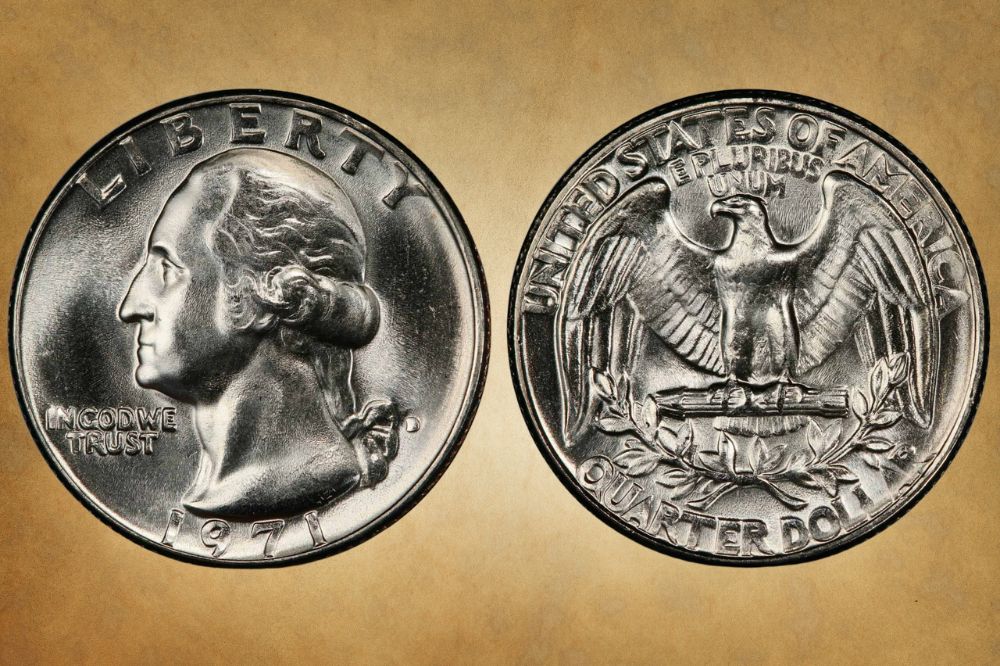
Are you curious about the 1971 Washington quarter? Do you wonder whether your coin is worth any money?
The Washington quarter is quite popular among coin collectors, and yours might be worth something depending on the coin’s condition and grade.
This article explains everything you need to know about the 1971 quarter value. You will discover the coin’s interesting history, features, and rare errors that might be worth millions of dollars if you know what to look for.
Let’s get started!
1971 Quarter Value Chart |
||||
| Mint mark | Good | Fine | Extremely Fine | Uncirculated |
| 1971 No mint mark Quarter Value | $0.30 | $0.30 | $0.30 | $1250 |
| 1971-D Quarter Value | $0.30 | $0.30 | $0.30 | $1,100 |
| 1971-S Proof Quarter Value | – | – | – | $7,574 |
1971 Quarter Value Guides
In this section, we will find out just how much is a 1971 quarter worth. There are three varieties of Washington quarters minted in 1971. These are:
- 1971 No-mint mark Quarter
- 1971-D Quarter
- 1971-S Proof Quarter
Let’s look at each coin variety and find out whether your 1971 Washington quarter is worth more than the face value of 25 cents.
1971 No-Mint mark Quarter Value
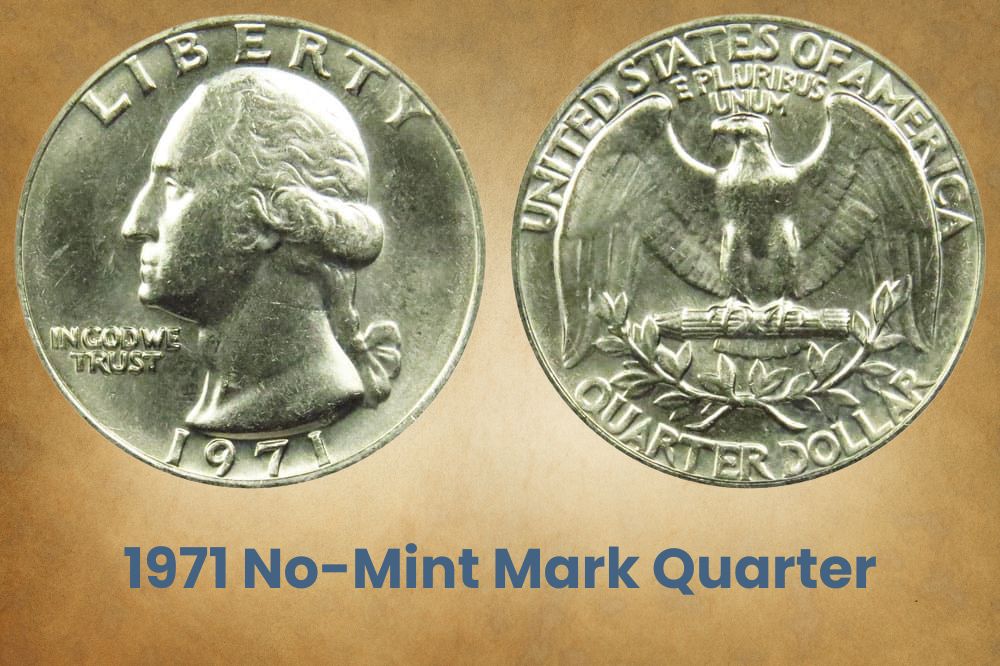
Out of all the three mints that struck the Washington quarter in 1971, the Philadelphia facility produced the second most quarters, estimated to be 109,284,000.
With such a high mintage, the no-mintmark 1971 quarter is certainly not rare, and you can easily find a relatively nice-looking one in both circulated and uncirculated condition.
The quarters struck in 1971 are generally of poor quality due to the Philadelphia mint overusing their die. A large number of poor-quality quarters means you must search a little longer for a fine-looking coin, even in uncirculated condition.
If you are not picky with the coins you collect, this is good, and you should easily acquire a circulated 1971 quarter at a pocket-friendly price of between $0.30 and $0.85.
As mentioned, even in uncirculated condition, 1971-P quarters still have a lot of scarring, faint lines, and understated luster. In mint state (MS) 63, you can obtain one for as little as $8 and $10 for a quarter graded MS65.
According to the Professional Coin Grading Service (PCGS), there are eight examples of the finest 1971 quarters graded MS67. The most recent example, graded MS67, was sold in 2019 at $3840.
1971-D Quarter Value
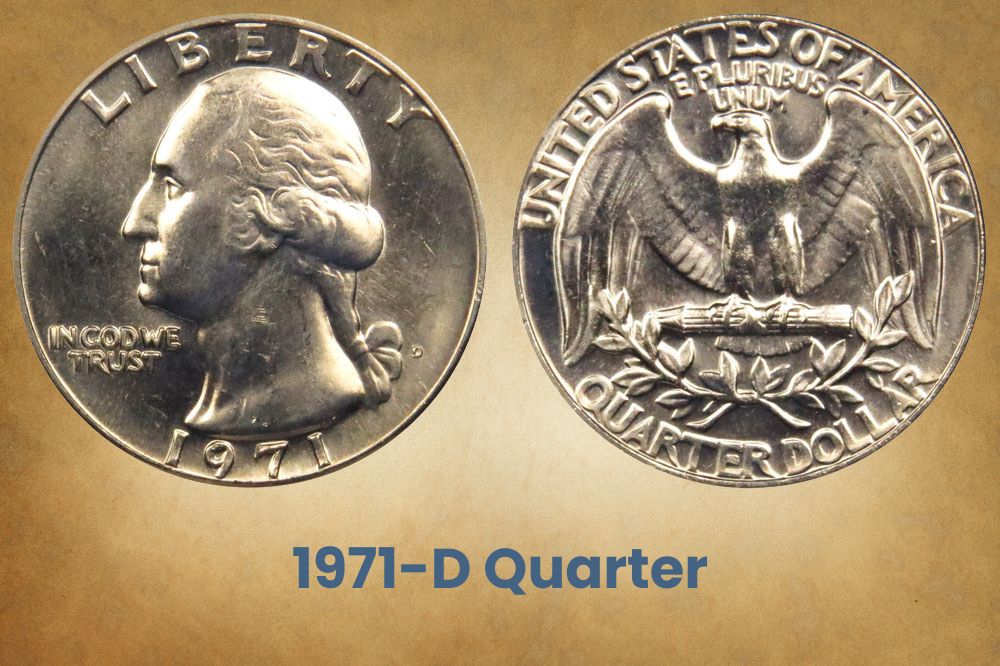
The Denver coin presses struck the highest number of Washington quarters in 1971 at over 250 million. The quality of coins that came out of Denver was much better than their Philadelphian counterparts, but this doesn’t make the Denver coins any cheaper than the Philly ones.
The high mintage means the 1971-D is readily available in circulation. You can easily and cheaply get your hands on a quarter in grades MS63 and lower. Quarters from this year in MS66 to MS67 are quite rare and will command a premium.
In circulated condition, for example, from Grade Good (G) all through to About Uncirculated 58 (AU), you can easily grab yourself a 1971-D quarter for between $0.30 and $0.85.
Going a little higher, in grade MS63, you can get your hands on a good-looking quarter for about $8 and as much as $1,100 for the finest example, graded MS68.
PCGS’s most recent records show only six examples of 1971-D in MS67 and only 2 in MS68.
The finest example, graded M68, was sold at an auction in 2019 at $4,560.
1971-S Proof Quarter Value
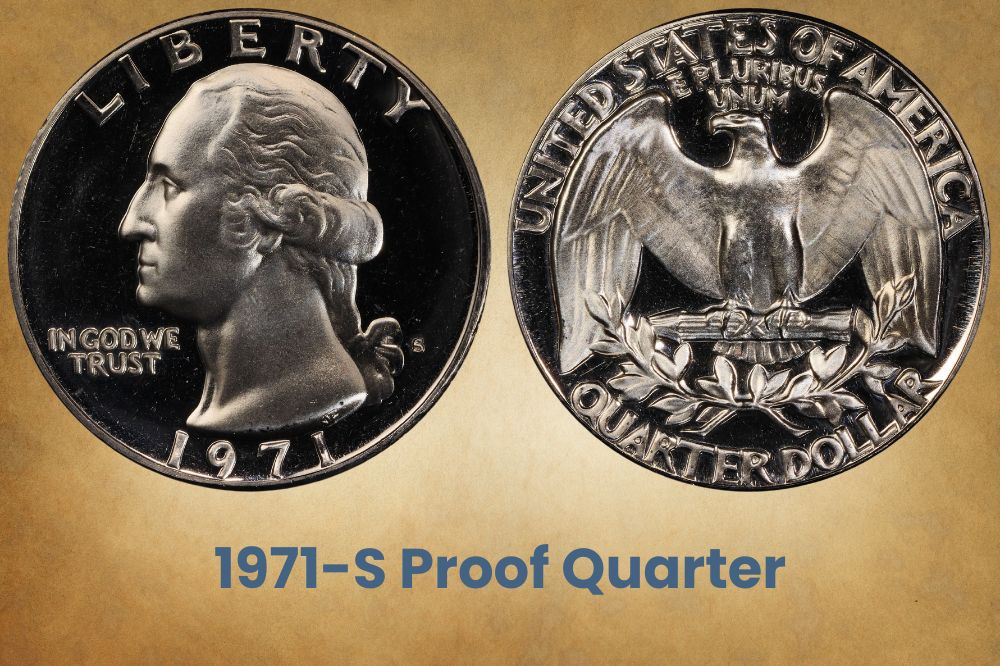
The United States Mint produces proof sets with a few highlight, cameo and deep cameo, uncirculated coins for collectors.
In 1971, the proof sets came from the San Francisco facility, known for better strikes than the Denver and Philadelphia ones. That year, the mint produced about 3,200,000 proof coins, significantly more than the low number of proofs that mints typically strike.
Examples of the 1971-S proof are available in Proof, Cameo, and Deep Cameo conditions. The latest PCGS records show about 429 examples of 1971-S proof quarters in grade PR67, 1228 in PR68, 1722 in PR69, and just 1 Deep Cameo grade PR70.
Proof quarters from 1971 are quite affordable, mostly because of the high mintage, which makes these coins readily available in the open market.
Expect to pay about $2.30 for a 1971-S proof graded MS60 and $10 for one graded PR65.
The finest example of a 1971-proof quarter with a red-brownish patina was graded PR70 and sold for $4,000 in 2023. A Cameo example graded PR69 was sold in an auction in 2003, fetching $242, while a Deep Cameo graded PR69 was sold for $7574 at auction.
Related Posts: 17 Most Valuable Modern Quarters Worth Money
1971 Quarter Errors
As you can tell from the high mintage, 1971 Washington quarters are not rare; you can get your hands on the remaining examples at a relatively affordable price.
That said, some quarters from 1917 are rare, particularly those with minting-related errors. These rare error coins can be worth hundreds of thousands.
Here are some common error coins from 1971.
1971 Quarter Doubled Die Reverse Error
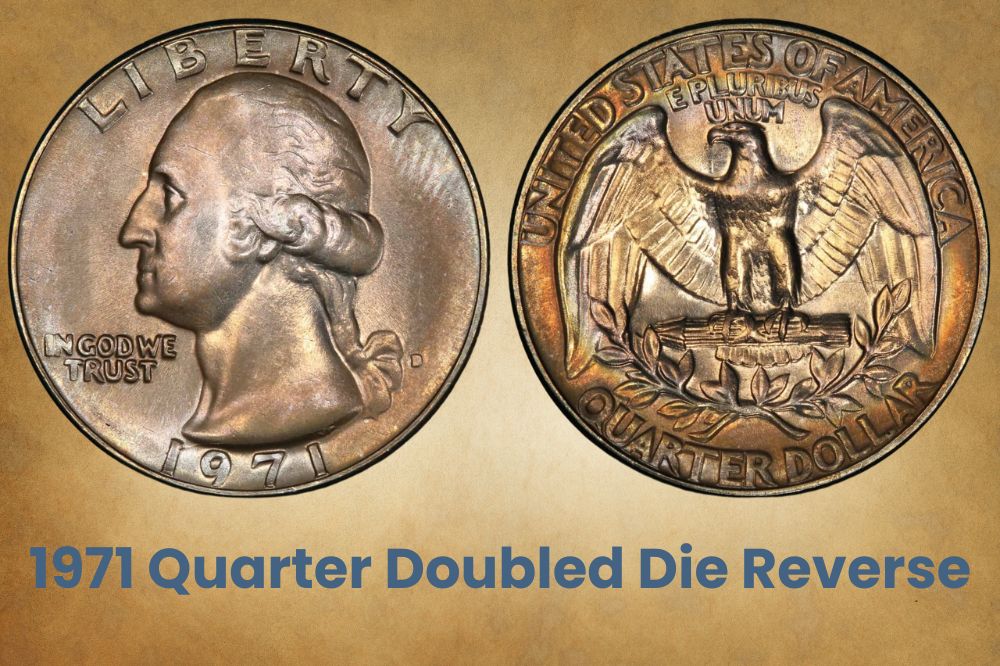
A doubled die error occurs when there is a misalignment between the hub and die. There are several types of doubled die errors occurring from such a misalignment. For example, you might encounter a design hub doubling error or a distended, distorted, offset, or even pivoted error.
Ultimately, a doubled die error will result in the doubling of one or more design elements on the coin. The doubling can be extreme or subtle; the more extreme, the more valuable the error becomes.
Some 1971 quarters will show doubling on the date and the word LIBERTY on the obverse. Depending on the extent of doubling, a doubled die error on a 1971 quarter can fetch between $10 and $100, with extreme doubling increasing the coin’s value.
1971 Quarter Broad Struck Error
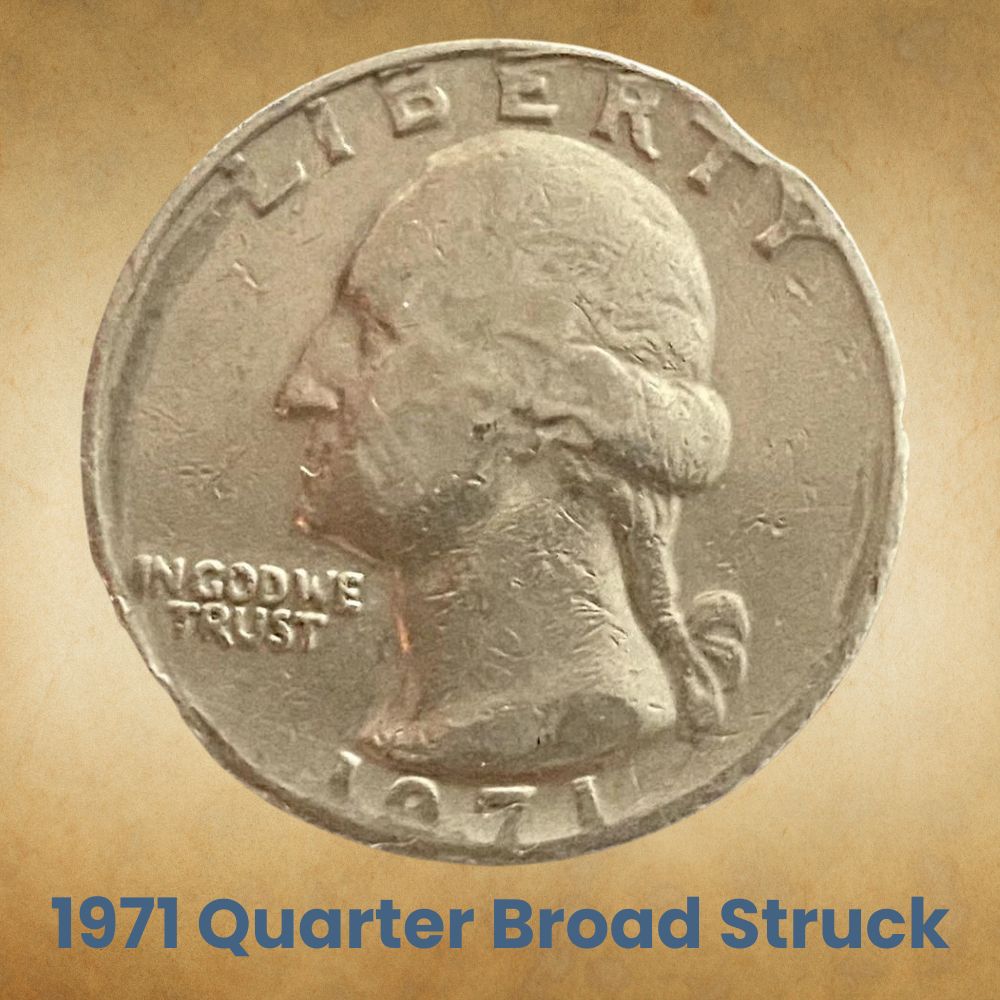
Broad strikes are quite common, especially among 1971-P quarters that were generally poorly struck.
A broad-struck error happens when the coin is struck outside its retaining collar. The collar is responsible for holding the coin and defining its diameter. A broad strike error is inevitable when the die strikes the coin beyond its normal diameter.
A properly centred coin struck outside the collar is known as a general strike, while an improperly centred one is known as an uncentered broad strike error.
For a coin to qualify as a broad strike, the obverse and reverse designs must be fully present.
Broad strikes are quite fascinating to coin collectors. One 1971 quarter broad strike error with its obverse and reverse designs intact sold for $400
1971 Quarter Clipped Planchet Error
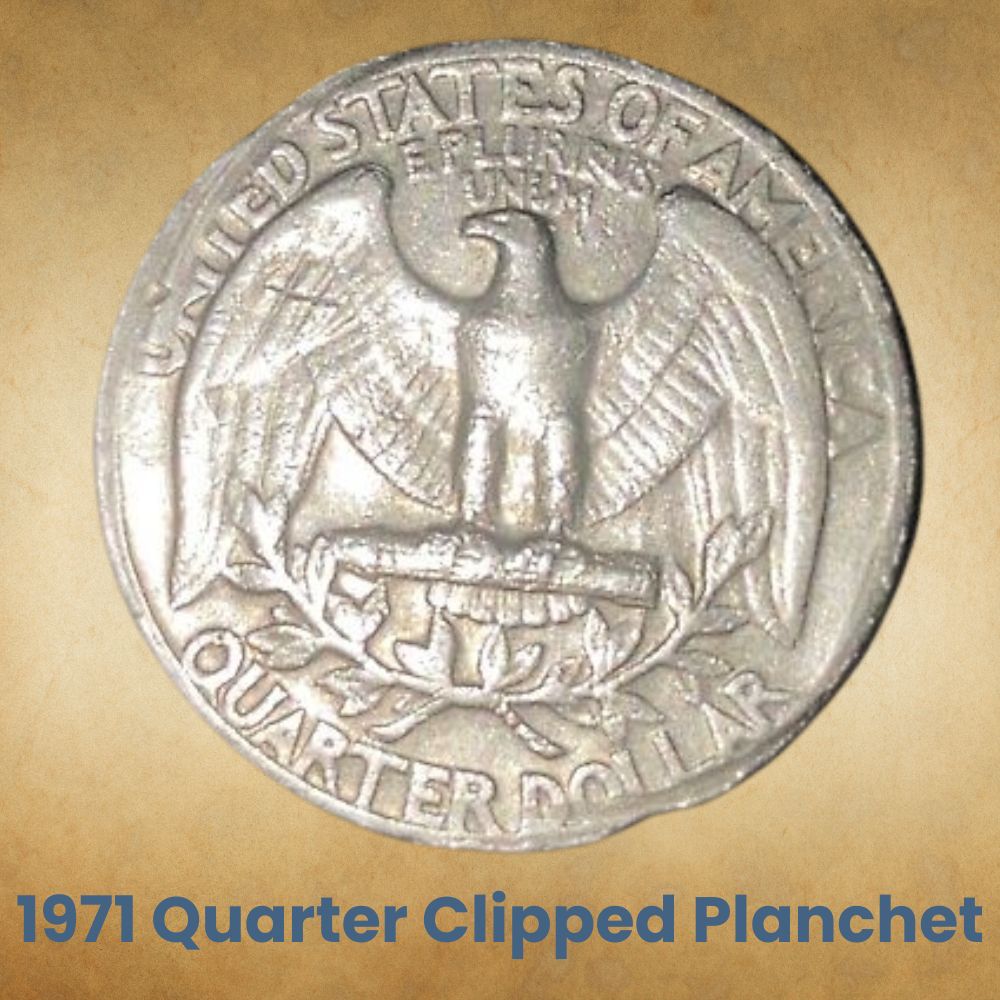
A clipped planchet error is also fascinating and sought-after. The error occurs when a blanking die overlaps a punched hole in the coin’s rim. This mishap results in blank edges with a concave shape, as if a piece of the coin was bitten out.
It is common for people to claim that their coin error is a clipped planchet when it actually isn’t. Whether you are buying or selling your 1971 quarter with a supposed planchet error, you should ensure that it is an actual error.
There are five things to look for to identify a clipped planchet error:
Blakesley effect: Check that the edge opposite the clip has a weak or missing rim.
The design along the clip looks smeared or stretched out.
The clip’s exposed edge will show a breakaway line in which the upper or lower half will be smooth and the other half rough.
The rim tapers toward and fades into the clipped edge.
In copper-clad coins, the normal position of the exposed copper core and normal coin edge is reversed.
A 1971 quarter clipped planchet coin can fetch anything between $10 and $100, with error coins with the date visible and intact attracting premium prices.
Related Posts: 16 Most Valuable Quarter Errors
History of the 1971 Quarter
The 1971 quarter is part of the Washington quarter coin series, first struck in 1932 to commemorate President George Washington’s 200th birthday anniversary.
Congress wanted to replace the Standing Liberty quarter with a new quarter depicting Washington’s portrait. The Bicentennial Committee congress, established to oversee the celebrations, thought it best to temporarily replace the Walking Liberty half dollar with the new commemorative coin.
In the end, despite protestations by members of the Bicentennial Committee, Congress settled on permanently replacing the Standing Liberty with a Washington quarter.
The Committee, alongside the Commission of Fine Arts, held a competition to select an artist to design the coin. The obverse design was to be based on Jean-Antoine Houdon’s sculpture of George Washington (1786), while the reverse design was left up to the artist.
Ultimately, the Committee and Commission chose Laura Gardin Fraser’s design after the competition. But, Treasury Secretary Andrew Mellon, the final decision maker, rejected Fraser as the chosen artist despite her experience as a sculptor and coin designer. Mellon instead opted for John Flanagan’s design.
Production of the Washington quarter began immediately, and the coins were in circulation by August 1, 1932.
The 1971 quarter features the same obverse and reverse design features as the original 1932 quarter. But these early coins were struck in silver up until 1964, after which the Mint changed the coin’s composition to copper and nickel.
The mint struck more than 371 million Washington quarters in 1971 across all three mints: Philadelphia, Denver, and San Francisco. As you can tell, the 1971 Washington quarter is common, but is it worth any money? Let’s find out.
Related Posts: Top 10 Most Valuable Bicentennial Quarters Worth Money
How to identify 1971 Quarter?
Familiarizing yourself with a coin’s features can help you know what to look for to determine if your 1971 Washington quarter is worth anything more than face value.
The Obverse of the 1971 Quarter
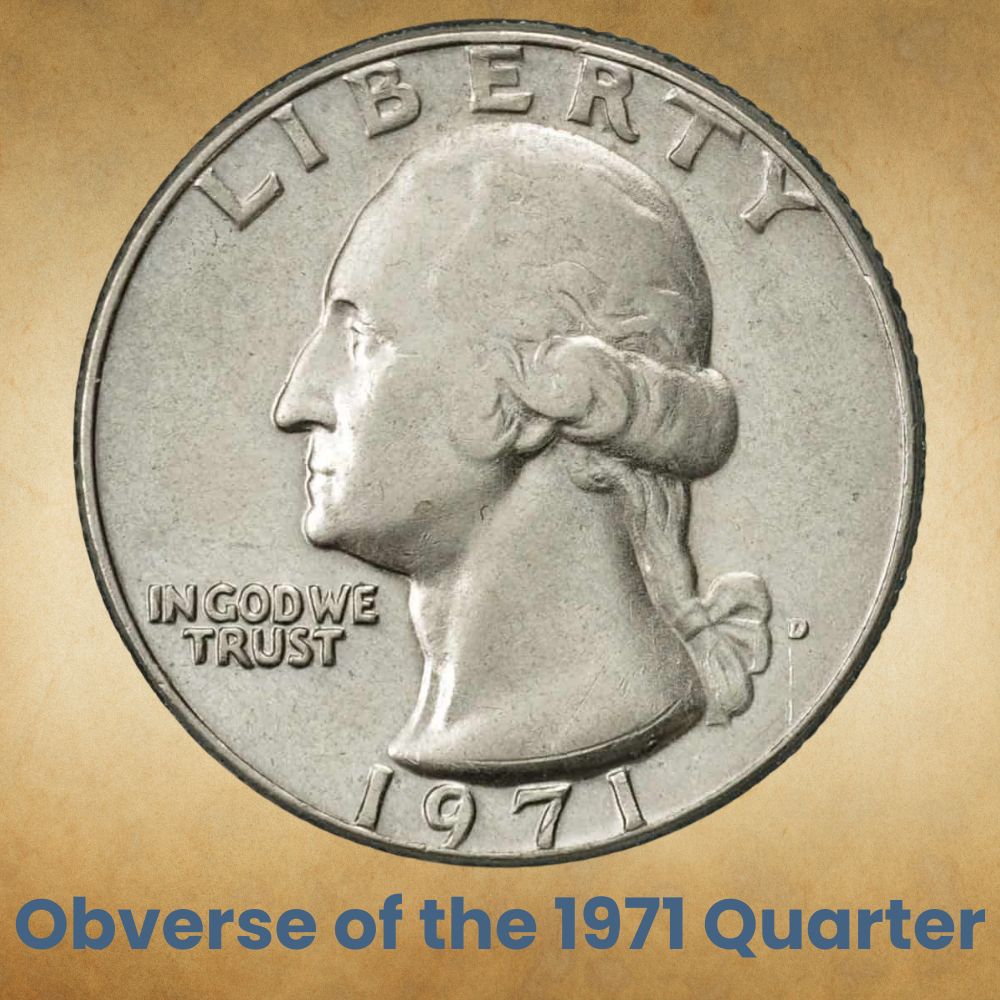
The obverse is the top side of a coin. The 1971 Washington quarter derives its name from the obverse design, which features the left-facing portrait of President George Washington.
The word LIBERTY appears at the top while the date, 1971, is etched at the bottom.
The motto IN GOD WE TRUST appears on the left field.
The obverse design of the 1971 quarter is the same as the original John Flanagan design of 1932 based on Jean-Antoine Houdon, sculptor of Washington (1786).
The Reverse of the 1971 Quarter
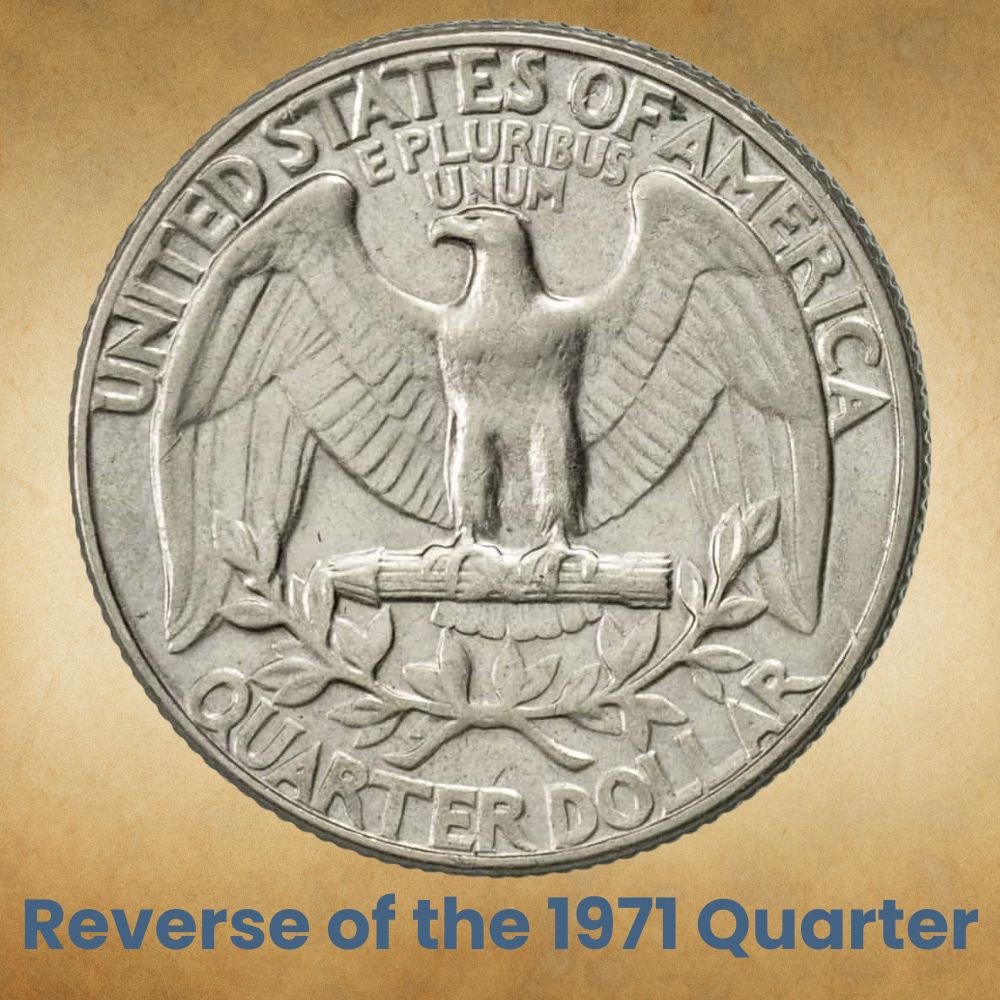
While the coin’s obverse was strictly based on Jean-Antoine Houdon’s bust sculpture, the artist was free to create their own design at the back of the Washington quarters, including the 1971 quarter.
Flanagan’s reverse design of the 1971 quarter features a left-facing heraldic eagle with wings spread out. The bird is perched on a bunch of arrows.
At the top of the bird’s head are the words E PLURIBUS UNUM, Latin for “Out of many, One.” At the bottom, underneath the bunch of arrows, are two olive branches tied together to form a laurel.
The words UNITED STATES OF AMERICA appear at the very top of the coin, while the coin’s denomination, QUARTER DOLLAR, is etched at the bottom.
Other Features of the 1971 Quarter
The earlier versions of the Washington quarters, between 1932 and 1964, were made of 90% silver and 10% copper. Starting in 1965, the coin’s composition changed to a copper and nickel clad over a copper center.
The 1971 quarter is therefore made of 75% copper and 25% nickel over a pure copper center.
It weighs 5.67 grams, measures 24.30 millimeters in diameter, and has a reeded edge.
The 1971 quarters struck at the Philadelphia coin presses do not have a mintmark. The proofs minted in San Francisco have no mintmark either. But, a mintmark D appears on the obverse on the right field next to Washington’s ponytail for coins minted in Denver.
Related Posts: 20 Most Valuable State Quarters Worth Money
Where is the mint mark on a 1971 Washington quarter?
Only the quarters minted in Denver have a mintmark; those minted in Philadelphia and the proofs struck in San Francisco do not have one. You can sport the D for Denver mintmark on the obverse of the 1971 quarter on the right field next to Washington’s ponytail.
Does the 1971 quarter have silver?
The Mint stopped using silver in coin-making starting in 1965 onward. The high silver metal prices and the depleting bullion reserves saw the mint switch to copper and alloys. As such, 1979 quarters do not contain silver; rather, they are made up of a pure copper center clad with 75 percent silver and 25 percent copper.
Why are 1971 quarters rare?
A 1971 quarter with an error might be a rare find. Aside from the coins struck in Philadelphia, the ones from Denver and the proofs from San Francisco were generally well-struck with few error examples. That said, 1971 quarters are not rare; with more than 350 million minted that year, you can easily and affordably get your hands on a 1971 Washington quarter.
Related Posts: 21 Most Valuable Quarters In Circulation
